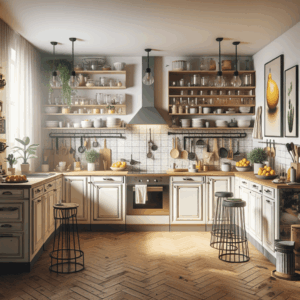Currently, interior decoration has become a way to express personal style, where the correct combination of light and textures plays a fundamental role in creating cozy and harmonious spaces. To assist in this purpose, interior design experts have created a comprehensive guide offering practical tips on achieving the perfect fusion of these two elements.
Light becomes a key player in any environment. Its proper use can significantly transform the perception of a space. There are two main types of lighting: natural, coming from windows and openings, and artificial, ranging from lamps to various lighting styles. To optimize natural light, it is suggested to use light curtains that allow light to pass through while maintaining privacy. For artificial lighting, a combination of warm and cool lights is recommended to help create different atmospheres depending on the time of day or occasion.
As for textures, they are elements that add depth and character to any room. From soft linen fabrics on cushions to rough stone finishes on walls, the variety of textures allows you to play with the senses and enrich the visual aesthetic. However, combining them requires attention, always seeking balance. Designers advise selecting a dominant texture and complementing it with others that subtly contrast, such as a black velvet sofa paired with cotton pillows with patterns that offer an attractive visual contrast.
The color palette also plays a crucial role in the interaction of light and textures. Light and neutral colors will maximize light, creating a sense of spaciousness, while darker tones provide warmth and comfort, although careful planning is required to avoid the space feeling oppressive. The choice of colors should be aligned with the texture, as a glossy material will reflect light, while a matte one tends to absorb it.
Another aspect to consider when combining light and textures is the arrangement of furniture. The distribution of elements in a space affects how light and textures interact. It is recommended to maintain proper flow and circulation, avoiding obstructing light sources.
Additionally, incorporating plants and natural elements not only adds texture but also introduces a luminous intensity that changes over time. Green leaves are capable of reflecting light and bringing life to a space, while their organic textures perfectly complement more industrial materials.
Lastly, personalization becomes an essential aspect. Every home is unique, and the way light and textures are combined should reflect the style and preferences of those inhabiting the space. The guide emphasizes the importance of experimenting, trying out different approaches, and above all, enjoying the creative process.
By following these tips, anyone can transform their home into a stylish and comfortable refuge, where light and textures intertwine in a magical way, creating an environment that invites relaxation and enjoyment. With the right approach, the combination of these elements not only beautifies spaces but also enhances the quality of life for those living in them.
via: MiMub in Spanish









